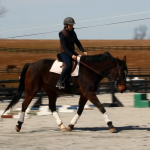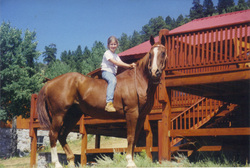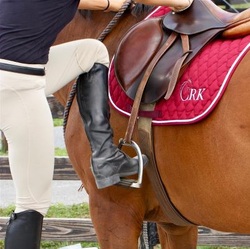One of the most important fundamentals of riding and training horses is improving the way our horses move, and sometimes just making sure we aren’t accidentally interfering with their movement.
When our horses move better, the ride is more comfortable, the horse’s muscles develop correctly, and moving better can even help horses stay more sound over the long term.
For many horses, improving their movement and creating a better ride, as well as correcting other issues such as bucking or balking, starts with getting more forward motion. Of course, there are other things to take into account – for example, if a horse is hollow going faster isn’t necessarily going to fix that, but we’ll talk about that a bit more in the video…
In today’s video, I share the three points that I find are most important for getting that more forward movement and improving your horse’s way of going.
Click play below to watch the video, then leave a comment!














14 Responses
What kind of bridle are you using on Bandit?
The bridle is a sidepull – its a very simple type of bitless bridle. I only started using it recently, but I really like it because it only puts pressure on the nose and provides an instant release unlike some other styles of bitless bridles.
Thanks Callie. The visual on getting the good walk and then the stretch rather than pulling/pushing onto the bit was great. Also wondering about the bridle.
Same question for me… What kind of bridle are you using? I can’t wait to try this because she is constantly bringing her head up. THANKS!!! great video
I have not taught my horse any of this. Where do I get some help on training my horse to stretch? I remember trying to get his nose to tuck a few weeks ago, but every time I asked for it, he thought I was asking him to stop. Thank you, Callie for the video. I’m grateful to know what “hollow” means and “brace”. I did learn some new things that will help me and my horses.
Hi Callie,
I am fairly new to riding (coming up on two years), and I only ride lesson horses. Do you have any tips for improving the forward – ness in a lesson horse who may be having a lazy day? I’m 46, and some lessons completely wear me out just trying to get my horse – of – the – day to go.
Thanks in advance!
I too have only been riding for a couple of years and I am almost 60, but decided to lease a lesson horse at a small barn. The lesson horses have so many different riders they get into a lot of bad habits, so for me it was working with her everyday, being consistent in how I ride her and then always trying to end on a good note. If only posting at a steady pace three times around the arena was better than the last week of stopping and starting that is where I would end. I try to change up what I do with her because I am sure she is bored from having to do the same thing everyday in lessons. Sometimes I will work on ground work, or sometimes Callie will post things that she is working on with a horse and I will try those things with her. Just to give her a change of pace. Plus I think if you win over a mare’s heart she is going to respond to that when you ride her, in my opinion!!! We are having a blast together… hope this helps.
Hi Debbie, thanks for taking the time to respond! I would love to be able to lease someday- riding so many different horses is good, I think, but it’d be nice to work with just one, if only for the chance to really form a partnership.
I have been riding one pretty consistently lately, though, and when I got to her stall the other day, I actually got a nicker!! I guess it’s possible she thought I had food, but I’m telling myself she was glad to see me. =)
Nice to hear from a fellow adult beginner!
laurie
I think she was happy to see you 🙂
Hi Laurie,
That is a common problem with lesson horses because they do learn to simply ignore all but the strongest pressure. However, a big reason that they do learn to ignore pressure is because it is constant but inconsistent – what I mean by this is that the horses learn to go forward only when they are being constantly coaxed with leg or a whip. The key to having them go forward from light cues is to be very consistent with the sequence of cue, pressure, release. Your cue could be a squeeze with the leg or a verbal cue such as “trot”, then you add pressure (I like tapping with a long whip), and release or stop that pressure immediatly when the horse moves forward. The consistency of keeping the pressure on and only releasing it (but doing so instantly) when they move forward is the key to teaching the horse to go from the cue to avoid the pressure. With a lesson horse who gets ridden by many different people, you may have to essentially retrain this the first few minutes of each of your rides. I hope this helps! Callie
Callie, thanks so much for the reply. You’ve reinforced what my instructor has been telling me! It’s a little hard as a beginner to get my timing just right, especially when I’m still so focused on my own position, but I’ve learned everything is easier when your horse is forward!
Thanks again, really appreciate your videos and blog posts!
laurie
Hi Callie,
What queue do you use with your reins to ask the horse to stretch once in a nice forward pace? Do you apply very slight pressure with both hands?
Thanks!
Sheryl
Hi Sheryl, Yes, I take contact with both reins to ask for stretch. If the horse feels stuck, I will often ask for a little flexion to the inside and I find that this often helps them find the stretch.
Lots of very important information in this excellent video. Thank you.